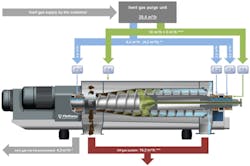Preventing oxidation with sealed centrifuges and inert gas blanketing
Traditionally, solids and liquids have been separated by filtration or with press equipment. While these methods are effective, modern automated separation technology is an excellent alternative for a faster separation and more efficient approach.
Many products are vulnerable to oxidation. Eliminating or at least minimizing oxygen concentration in the atmosphere within the separation system is imperative to protect product quality, shelf life and efficacy.
Centrifuge separation systems that are sealed and that use inert gas blanketing can be used safely and effectively while avoiding oxygen exposure.
Some applications in which sealed, inert gas blanketed centrifuges are used include:
- Edible oils and fats (e.g., olive, seed, animal fats)
- Fruit and vegetable juices
- Beer clarification
- Plant and algae extracts
- Pharmaceuticals
This article explains how technically sealed decanter centrifuges, blanketed with inert gas, improve efficiency and safety in dewatering and separating oxygen-sensitive materials.
How are centrifuges sealed?
There are three different approaches for inert gas purging of equipment:
- Overpressure. This method can only be used with equipment that is designed for over-pressure. The air inside is removed by continually adding and releasing high-pressure inert gas into the sealed equipment. This step is repeated until the oxygen concentration inside the equipment measures at the desired level. Then while the equipment is running, the internal pressure is held at a higher differential pressure than the atmosphere (though this operating pressure is still much lower than that used during inertization).
- Vacuum. All air inside the equipment is removed by evacuating the equipment. Then the vacuum is broken by flushing with inert gas. Depending on the equipment, this procedure must be repeated one or two times. Equipment designed for holding vacuum is required for this process.
- Continuous flow purging: This method is used for plants, machines, containers and equipment that is not designed for high over-pressure or vacuum. It works by feeding inert gas into the equipment at one point in the closed system, and simultaneously releasing it at another point at a distance away from the infeed. There is typically a pre-purge sequence at higher flow rates and a blanketing sequence during normal operation of the equipment.
The centrifuge systems discussed in this article use a version of the third method, continuous flow purging. It is also important to note that continuous flow purged centrifuge systems are “technically tight,” which is different from being hermetically sealed. A hermetically sealed piece of equipment provides a zero-leakage tolerance, while the “tightness” in a technically tight system cannot be permanently ensured due to its design, function, etc.
A design concept that adapts to many applications
The basic design used for preventing oxidation can be customized to specific materials and settings. The air within the centrifuge is replaced by an inert gas, usually nitrogen or carbon dioxide. This forms a seal that keeps oxygen out and maintains the required atmosphere for processing the material.
Proper internal atmosphere means higher product quality and safety
Exposure to atmospheric oxygen inside the centrifuge can lead to oxidation and further to product degradation or loss of quality. The goal of a sealed centrifuge system is to achieve and maintain the desired limiting oxygen concentration (LOC) inside the decanter system.
2 steps to creating an internal atmosphere that meets the desired atmospheric composition: Pre-purge and inert gas blanketing.
The pre-purge step occurs before the machine is started. The interior of the centrifuge is flushed with inert gas (e.g., carbon dioxide or nitrogen) to displace the oxygen. This is done by filling the housing until the pressure exceeds 0.290 PSI and continues until the flow of inert gas has replaced the interior volume of the centrifuge multiple times over or until an oxygen sensor indicates the required concentration of oxygen, or both. The amount of time this takes varies according to the decanter size but is usually less than 30 minutes.
After purging, the inside of the centrifuge is “blanketed” with the inert gas, forming a technically tight seal. In this step, the system is held at a slight overpressure. This results in a constant differential pressure to the atmosphere, which prevents the outside atmosphere from penetrating the inside.
Importantly, the inert gas supply system must be equipped with sufficient redundancy to guarantee the continuous availability of gas during centrifuge downtime in case of any failure.
How a purged and inert gas blanketing system works
A standard mathematical formula is used to calculate the amount of gas required to displace the volume of the decanter bowl. Once an adequate volume has been displaced and safe operating conditions are reached, the system is considered to be in an operational state (i.e., inert).
A seal consisting of several sealing rings separates the interior of the centrifuge from the outside atmosphere. By using multiple sealing elements, including additional seals on shaft feedthroughs and housings, a technically tight seal is created. This also reduces the amount of inert gas used since the seals help ensure minimal loss throughout the system.
Inert gas is fed between the sealing rings. It flows through narrow seal openings, both into the interior and to the atmosphere. This is only possible if the pressure at the seal face is higher than the pressure in the decanter housing (> 0.290 PSI) and the outside atmosphere. The differential pressure (0.725–1.45 PSI) between the housing and the gas feed point is monitored and controlled. Seals are pressurized, keeping oxygen from entering the system.
Oxygen monitoring sensors vs. continuous flow purge systems
Internal oxygen concentrations can be managed in two ways: with oxygen sensors or a continuous flow purge system. Oxygen sensors monitor the oxygen concentration inside the centrifuge housing. An advantage to using these sensors is the continuous monitoring they offer, especially if the differential pressure between the internal housing and the atmosphere is < 0.290 PSI.
Oxygen sensors provide direct information about the risk factor of the oxygen concentration. In contrast, a continuous flow purge system is indirect and relies on pressure sensor set points. As long as the overpressure on the seals/housing is maintained, no oxygen from the environment can penetrate the system and the oxygen concentration is held below the critical level. This is done with flowmeters and pressure gauges.
However, since continuous flow systems rely on pressure sensor set points, applications that call for lower differential pressures may be susceptible to erroneous system shutdowns. In these cases, oxygen sensors may provide more sensitive monitoring of this danger zone.
Both methods ensure safe operation if they are properly planned, installed and maintained. Unfortunately, the weak point with an oxygen sensor is the sensor itself, which requires PLC programming, calibration, periodic replacement and maintenance. Overall, continuous flow purging offers better net positive usability when compared with oxygen monitoring.
Why use nitrogen?
Nitrogen is commonly chosen for inert gas blanketing applications because it is nonreactive, readily available, and generally inexpensive. These are the requirements for using nitrogen with a sealed centrifuge system:
• Inlet pressure: 4– 6 bar (g)
• Purity level: min. 99 vol % N2 (max. 1 vol % O2)
• Filtration degree: 5 µm
• Inert gas temperature: 0– 60°C
• Moisture content from the inert gas:
- pressure dew point ≤ 3°C at temperatures above 3°C
- pressure dew point ≤ -20°C at temperatures below 3°C
A safe, efficient solution for separation
Using an inert gas to form a tightly sealed or purged centrifuge is an excellent solution for a variety of applications in the food, beverage and pharmaceutical industries, among others.
Once commissioned, a leak-tightness test schedule should be created and performed regularly to verify the tightness of the purge unit. Routine maintenance and testing points include manometers, flowmeters and hoses. Supply lines also must be checked at regular intervals for damage, clogs and tightness.
Centrifuges are extremely efficient, with higher throughput than filters or presses and they operate continuously, instead of in batches as with filters or presses. It is possible to separate two phases, three phases or a very light emulsion with a purged centrifuge. Many systems are also fully automated, which reduces operator time spent overseeing the machine.
Lee Betkowski has been the biotech, chemical, pharmaceutical (BCP) industry manager for Flottweg for 13 years. He has nearly 30 years of experience in the biotech/chemical/pharmaceutical industries, predominately with centrifuges.
Flottweg
About the Author
Lee Betkowski
Pharmaceutical processing expert at Flottweg Separation Technology.
Lee Betkowski is a pharmaceutical processing expert at Flottweg Separation Technology.





